Kuppan T. Heat Exchanger Design Handbook
Подождите немного. Документ загружается.

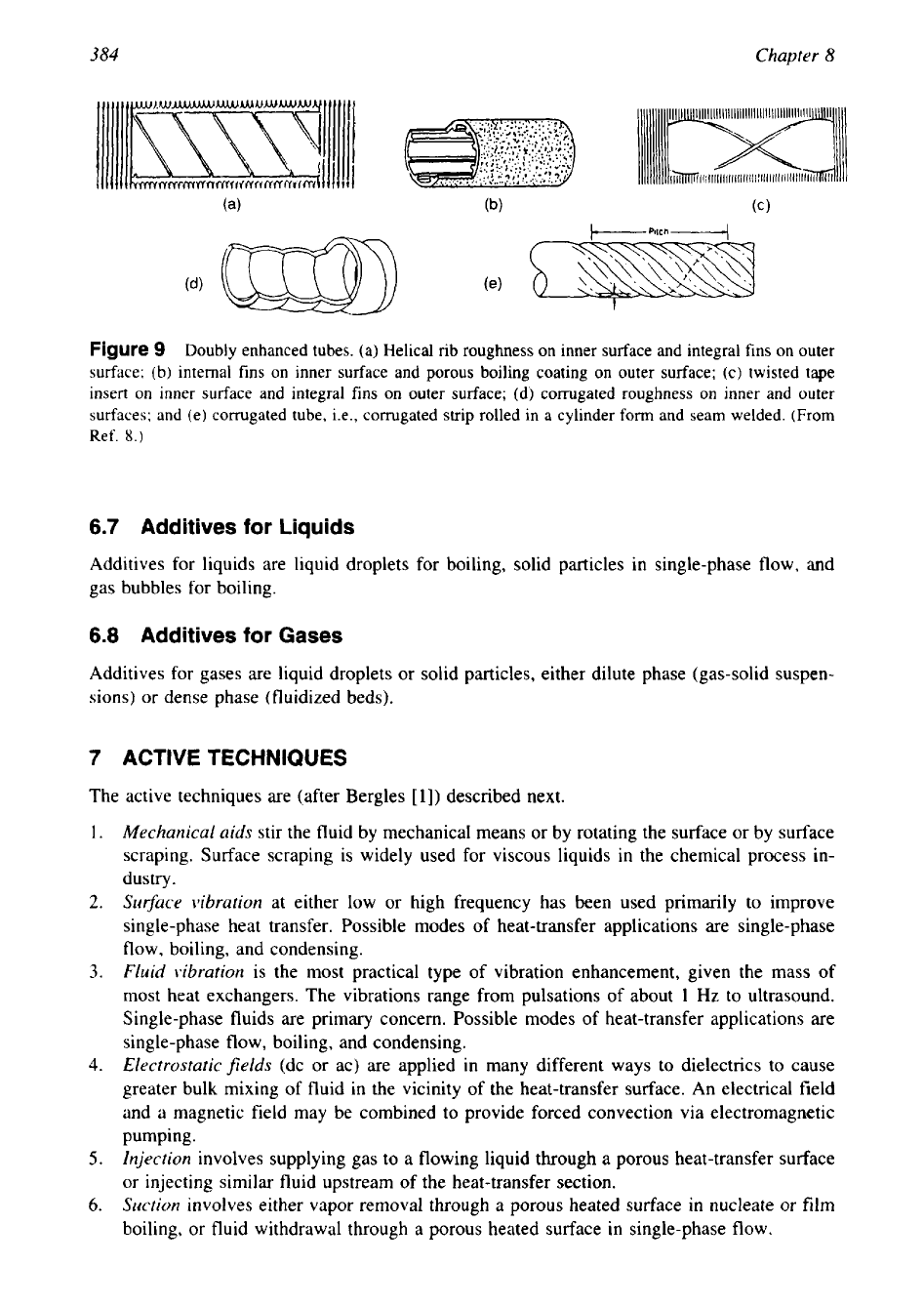
384
Chapter
8
Figure
9
Doubly enhanced tubes. (a) Helical rib roughness on inner surface and integral fins on outer
surface; (b) internal fins on inner surface and porous boiling coating on outer surface;
(c)
twisted tape
insert on inner surface and integral fins on outer surface; (d) corrugated roughness on inner and outer
surfaces; and (e) corrugated tube, i.e., corrugated
strip
rolled in a cylinder form and seam welded. (From
Ref.
8.)
6.7
Additives
for
Liquids
Additives for liquids are liquid droplets for boiling, solid particles in single-phase flow, and
gas bubbles for boiling.
6.8
Additives
for
Gases
Additives for gases are liquid droplets or solid particles, either dilute phase (gas-solid suspen-
sions) or dense phase (fluidized beds).
7
ACTIVE
TECHNIQUES
The active techniques are (after Bergles
[
13)
described next.
1.
Mechanical aids
stir the fluid by mechanical means or by rotating the surface or by surface
scraping. Surface scraping is widely used for viscous liquids in the chemical process in-
dustry.
2.
Sur$ace vibration
at either
low
or high frequency has been used primarily to improve
single-phase heat transfer. Possible modes of heat-transfer applications are single-phase
flow, boiling, and condensing.
3.
Fluid vibration
is the most practical type of vibration enhancement, given the mass
of
most heat exchangers. The vibrations range from pulsations
of
about
1
Hz
to ultrasound.
Single-phase fluids are primary concern. Possible modes of heat-transfer applications are
single-phase flow, boiling, and condensing.
4.
Electrostatic fields
(dc or ac) are applied in many different ways to dielectrics
to
cause
greater bulk mixing of fluid in the vicinity of the heat-transfer surface. An electrical field
and
a
magnetic field may be combined to provide forced convection via electromagnetic
pumping.
5.
Znjection
involves supplying gas to a flowing liquid through a porous heat-transfer surface
or injecting similar fluid upstream of the heat-transfer section.
6.
Suction
involves either vapor removal through a porous heated surface in nucleate or film
boiling, or fluid withdrawal through a porous heated surface in single-phase flow.
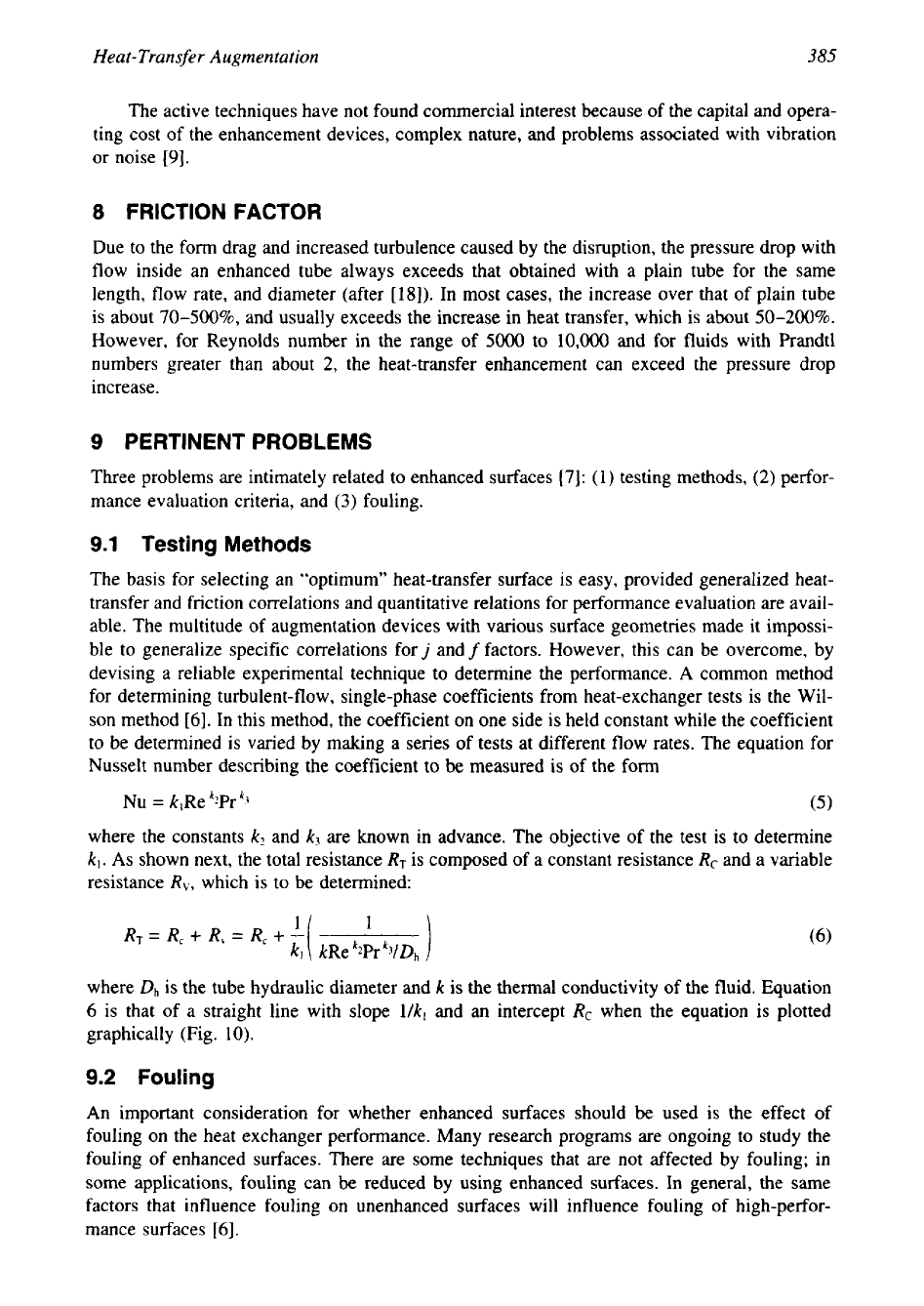
Heat- Transfer Augmentation
385
The active techniques have not found commercial interest because of the capital and opera-
ting cost of the enhancement devices, complex nature, and problems associated with vibration
or noise
[9].
8 FRICTION FACTOR
Due to the form drag and increased turbulence caused by the disruption, the pressure drop with
flow inside an enhanced tube always exceeds that obtained with a plain tube for the same
length, flow rate, and diameter (after [IS]). In most cases, the increase over that of plain tube
is about
70-500%,
and usually exceeds the increase in heat transfer, which is about
50-200%.
However, for Reynolds number in the range
of
SO00
to
10,000
and for fluids with Prandtl
numbers greater than about
2,
the heat-transfer enhancement can exceed the pressure drop
increase.
9
PERTINENT PROBLEMS
Three problems are intimately related to enhanced surfaces
[7]:
(1) testing methods,
(2)
perfor-
mance evaluation criteria, and
(3)
fouling.
9.1
Testing Methods
The basis for selecting an “optimum” heat-transfer surface is easy, provided generalized heat-
transfer and friction correlations and quantitative relations for performance evaluation are avail-
able. The multitude of augmentation devices with various surface geometries made it impossi-
ble to generalize specific correlations forj andffactors. However, this can be overcome, by
devising
a
reliable experimental technique to determine the performance.
A
common method
for determining turbulent-flow, single-phase coefficients from heat-exchanger tests is the Wil-
son method
[6].
In this method, the coefficient on one side is held constant while the coefficient
to be determined is varied
by
making a series of tests at different flow rates. The equation for
Nusselt number describing the coefficient
to
be
measured is of the form
Nu
=
klRe k2Pr
kj
(5)
where the constants
kz
and
k3
are known in advance. The objective of the test is to determine
kl.
As shown next, the total resistance
RT
is composed of a constant resistance
Rc
and a variable
resistance
Rv,
which is to be determined:
where
Dh
is the tube hydraulic diameter and
k
is the thermal conductivity of the fluid. Equation
6
is that of a straight line with slope llk, and an intercept
Rc
when the equation is plotted
graphically (Fig. 10).
9.2
Fouling
An important consideration for whether enhanced surfaces should be used is the effect of
fouling on the heat exchanger performance. Many research programs are ongoing to study the
fouling of enhanced surfaces. There are some techniques that are not affected by fouling; in
some applications, fouling can be reduced by using enhanced surfaces. In general, the same
factors that influence fouling on unenhanced surfaces will influence fouling of high-perfor-
mance surfaces
[6].
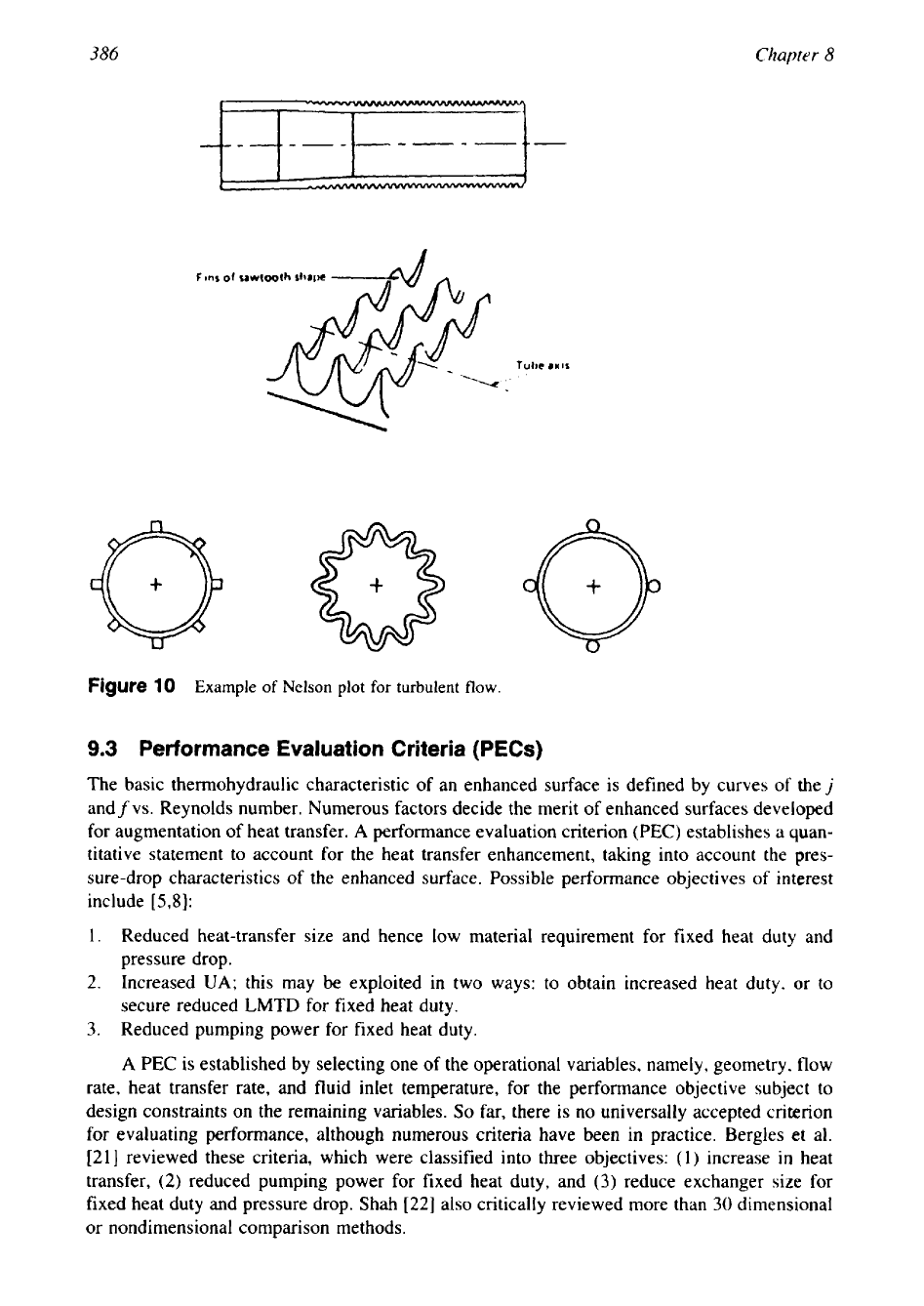
386
Chapter
8
Figure
10
Example
of
Nelson plot
for
turbulent
flow.
9.3
Performance Evaluation Criteria (PECs)
The basic thermohydraulic characteristic of an enhanced surface is defined by curves
of
thej
andf vs. Reynolds number. Numerous factors decide the merit of enhanced surfaces developed
for augmentation
of
heat transfer.
A
performance evaluation criterion
(PEC)
establishes a quan-
titative statement to account for the heat transfer enhancement, taking into account the pres-
sure-drop characteristics of the enhanced surface. Possible performance objectives
of
interest
include [5,8]:
I.
Reduced heat-transfer size and hence low material requirement for fixed heat duty and
pressure drop.
2.
Increased
UA;
this may be exploited in two ways: to obtain increased heat duty. or to
secure reduced
LMTD
for fixed heat duty.
3.
Reduced pumping power for fixed heat duty.
A
PEC
is established by selecting one of the operational variables, namely, geometry. flow
rate, heat transfer rate, and fluid inlet temperature, for the performance objective subject to
design constraints on the remaining variables.
So
far, there is
no
universally accepted criterion
for evaluating performance, although numerous criteria have been in practice. Bergles et al.
[21] reviewed these criteria, which were classified into three objectives:
(1)
increase in heat
transfer, (2) reduced pumping power for fixed heat duty, and
(3)
reduce exchanger size for
fixed heat duty and pressure drop. Shah [22] also critically reviewed more than
30
dimensional
or nondimensional comparison methods.
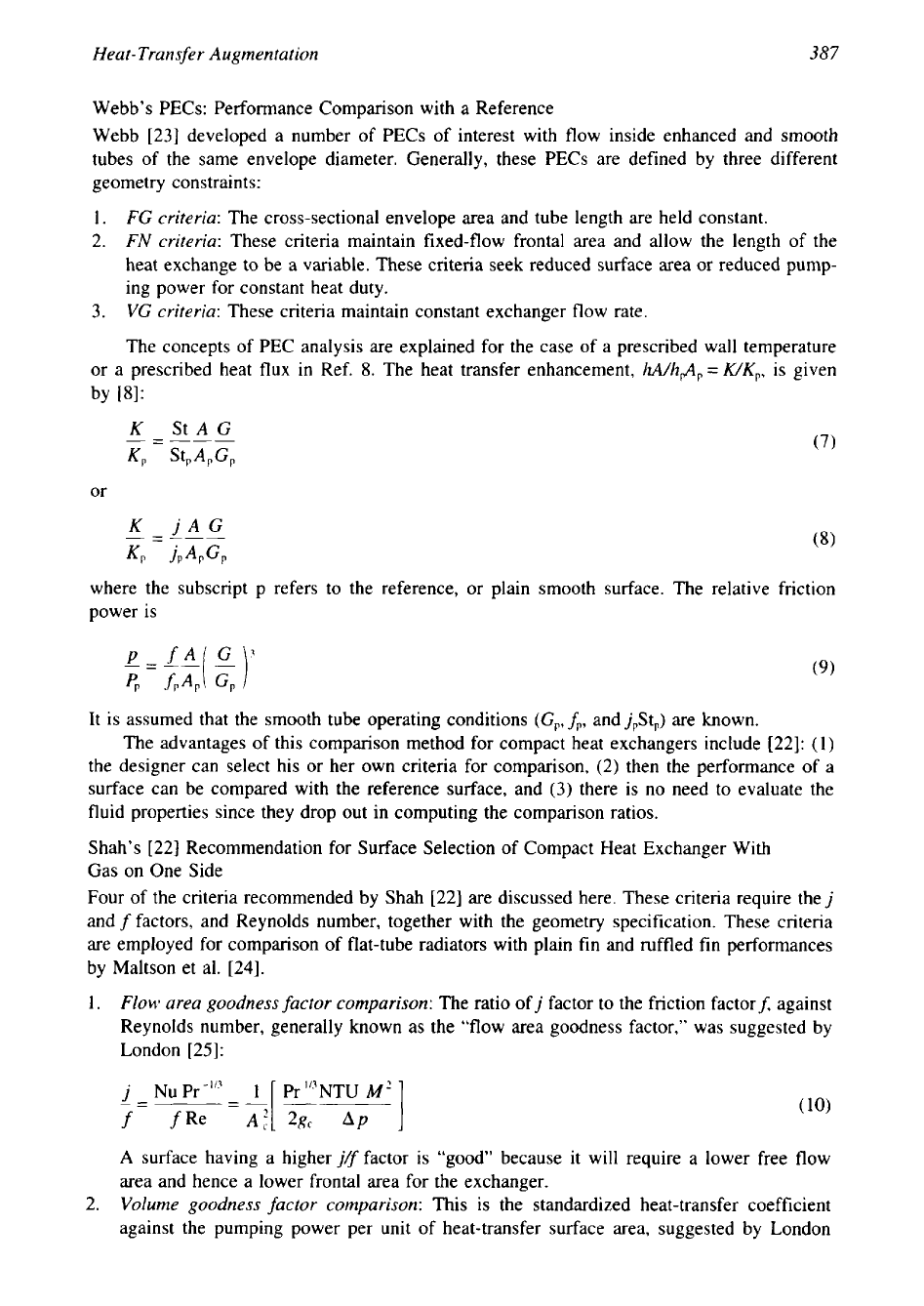
387
Heat- Transfer Augmentation
Webb’s PECs: Performance Comparison with a Reference
Webb
[23]
developed a number of PECs of interest with flow inside enhanced and smooth
tubes of the same envelope diameter. Generally, these PECs are defined by three different
geometry constraints:
1.
FG
criteria: The cross-sectional envelope area and tube length are held constant.
2.
FN
criteria: These criteria maintain fixed-flow frontal area and allow the length
of the
heat exchange
to
be a variable. These criteria seek reduced surface area or reduced
pump-
ing power for constant heat duty.
3.
VG
criteria: These criteria maintain constant exchanger flow rate.
The concepts of PEC analysis are explained for the case of a prescribed wall temperature
or a prescribed heat
flux in Ref.
8.
The heat transfer enhancement,
Whdp
=
WK,,
is given
by
PI:
K
StAG
_-
-
___
(7)
KP
StPAPGP
or
(8)
where the subscript
p refers to the reference, or plain smooth surface. The relative friction
power is
It
is
assumed that the smooth tube operating conditions
(Gp,
fp,
andjpStp) are known.
The advantages of this comparison method for compact heat exchangers include
[22]:
(1)
the designer can select his or her own criteria for comparison,
(2)
then the performance of a
surface can be compared with the reference surface, and
(3)
there is no need to evaluate the
fluid properties since they drop out in computing the comparison ratios.
Shah’s
[22]
Recommendation for Surface Selection of Compact Heat Exchanger With
Gas on One Side
Four of the criteria recommended by Shah
[22]
are discussed here. These criteria require thej
and
f
factors, and Reynolds number, together with the geometry specification. These criteria
are employed for comparison of flat-tube radiators with plain fin and ruffled fin performances
by Maltson et al.
[24].
1.
Flow
area goodness factor comparison: The ratio
ofj
factor to the friction factorf, against
Reynolds number, generally known as the “flow area goodness factor,” was suggested by
London
[25]:
A
surface having
a
higher jgfactor is “good” because it will require a lower free flow
area and hence a lower frontal area for the exchanger.
2.
Volume goodness factor comparison: This
is
the standardized heat-transfer coefficient
against the pumping power per unit of heat-transfer surface area, suggested by London

388
Chapter
8
and Ferguson [26]. Two types of comparison are suggested: (1)
h,td
versus
Elrd,
and
(2)
qohStdP
versus
E,,P
as given:
and
P
f
Re7p:ld
EIrd
=
=
A
2gcp
:dD;
3.
The performance of the heat exchanger per unit volume, the criterion suggested by Shah
[22]. This method includes the effect of the fin effectiveness.
A
good performance using
this criterion gives the best heat exchanger to use where the size of the unit is an important
consideration. Two types of comparison are suggested:
(1)
h,ld
versus
E,1d,
and (2)
q,,h,$
versus
Ell$
as given:
4.
The actual heat-transfer rate performance versus the gas side fan power, suggested by
Bergles et al. [27].
10
PHASE CHANGE
Even though heat transfer with phase change is not within the scope of this book, for sake of
completion, enhanced heat-transfer surfaces used for condensation and evaporation are men-
tioned. Enhanced surfaces used for phase change applications other than microfin tubes are
shown in Fig. 11. References 1,
5,
and 6 detail heat-transfer enhancement techniques for phase
change. One major area of application of enhanced heat-transfer surfaces for phase change-
applications
is
in refrigeration and air conditioning. Pate et al.
[lO]
and Bergles [I] detail
the application of heat-transfer enhancement techniques in refrigeration and air conditioning
industry.
10.1
Condensation Enhancement
The heat-transfer resistance in condensation
of
pure components is primarily due to conduction
across the condensate film thickness. Condensation enhancement is generally obtained by
tak-
Figure
1
1
Shellside enhancement devices for phase change (condensation and evaporation). (From
Ref.
2.)
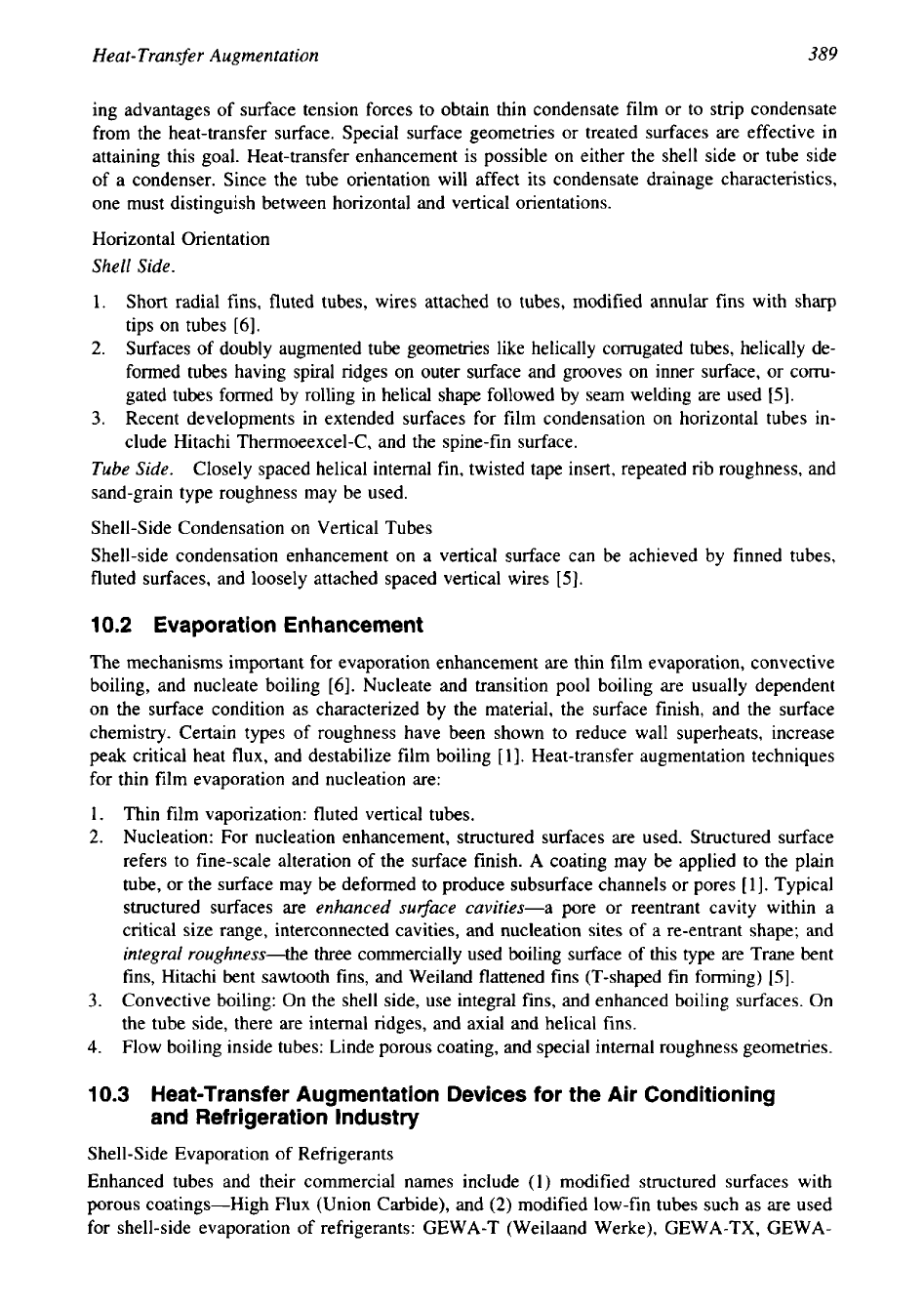
Heat- Transfer Augmentation
389
ing advantages of surface tension forces to obtain thin condensate film or to strip condensate
from the heat-transfer surface. Special surface geometries or treated surfaces are effective in
attaining this goal. Heat-transfer enhancement is possible on either the shell side or tube side
of a condenser. Since the tube orientation will affect its condensate drainage characteristics,
one must distinguish between horizontal and vertical orientations.
Horizontal Orientation
Shell Side.
1.
Short radial fins, fluted tubes, wires attached to tubes, modified annular fins with sharp
tips on tubes
[6].
2.
Surfaces of doubly augmented tube geometries like helically corrugated
tubes,
helically de-
formed tubes having spiral ridges on outer surface and grooves on inner surface, or corru-
gated tubes formed by rolling in helical shape followed by seam welding are used
[5].
3.
Recent developments in extended surfaces for film condensation on horizontal tubes in-
clude Hitachi Thennoeexcel-C, and the spine-fin surface.
Tube Side.
Closely spaced helical internal fin, twisted tape insert, repeated rib roughness, and
sand-grain type roughness may be used.
Shell-Side Condensation on Vertical Tubes
Shell-side condensation enhancement on a vertical surface can be achieved by finned tubes,
fluted surfaces, and loosely attached spaced vertical wires
[5].
10.2
Evaporation Enhancement
The mechanisms important for evaporation enhancement are thin film evaporation, convective
boiling, and nucleate boiling
[6].
Nucleate and transition pool boiling are usually dependent
on the surface condition as characterized by the material, the surface finish, and the surface
chemistry. Certain types of roughness have been shown to reduce wall superheats, increase
peak critical heat flux, and destabilize film boiling
[
11.
Heat-transfer augmentation techniques
for thin film evaporation and nucleation are:
1.
Thin film vaporization: fluted vertical tubes.
2.
Nucleation: For nucleation enhancement, structured surfaces are used. Structured surface
refers to fine-scale alteration of the surface finish. A coating may be applied to the plain
tube, or the surface may be deformed to produce subsurface channels or pores
[
11.
Typical
structured surfaces are enhanced su~ace cavities-a pore or reentrant cavity within a
critical size range, interconnected cavities, and nucleation sites of a re-entrant shape; and
integral roughness-the three commercially used boiling surface of this
type
are Trane
bent
fins, Hitachi bent sawtooth fins, and Weiland flattened fins (T-shaped fin forming)
[5].
3.
Convective boiling: On the shell side, use integral fins, and enhanced boiling surfaces. On
the tube side, there are internal ridges, and axial and helical fins.
4.
Flow boiling inside tubes: Linde porous coating, and special internal roughness geometries.
10.3
Heat-Transfer Augmentation Devices for the Air Conditioning
and Refrigeration Industry
Shell-Side Evaporation of Refrigerants
Enhanced tubes and their commercial names include (1) modified structured surfaces with
porous coatings-High Flux (Union Carbide), and
(2)
modified low-fin tubes such as are used
for shell-side evaporation of refrigerants: GEWA-T (Weilaand Werke), GEWA-TX, GEWA-
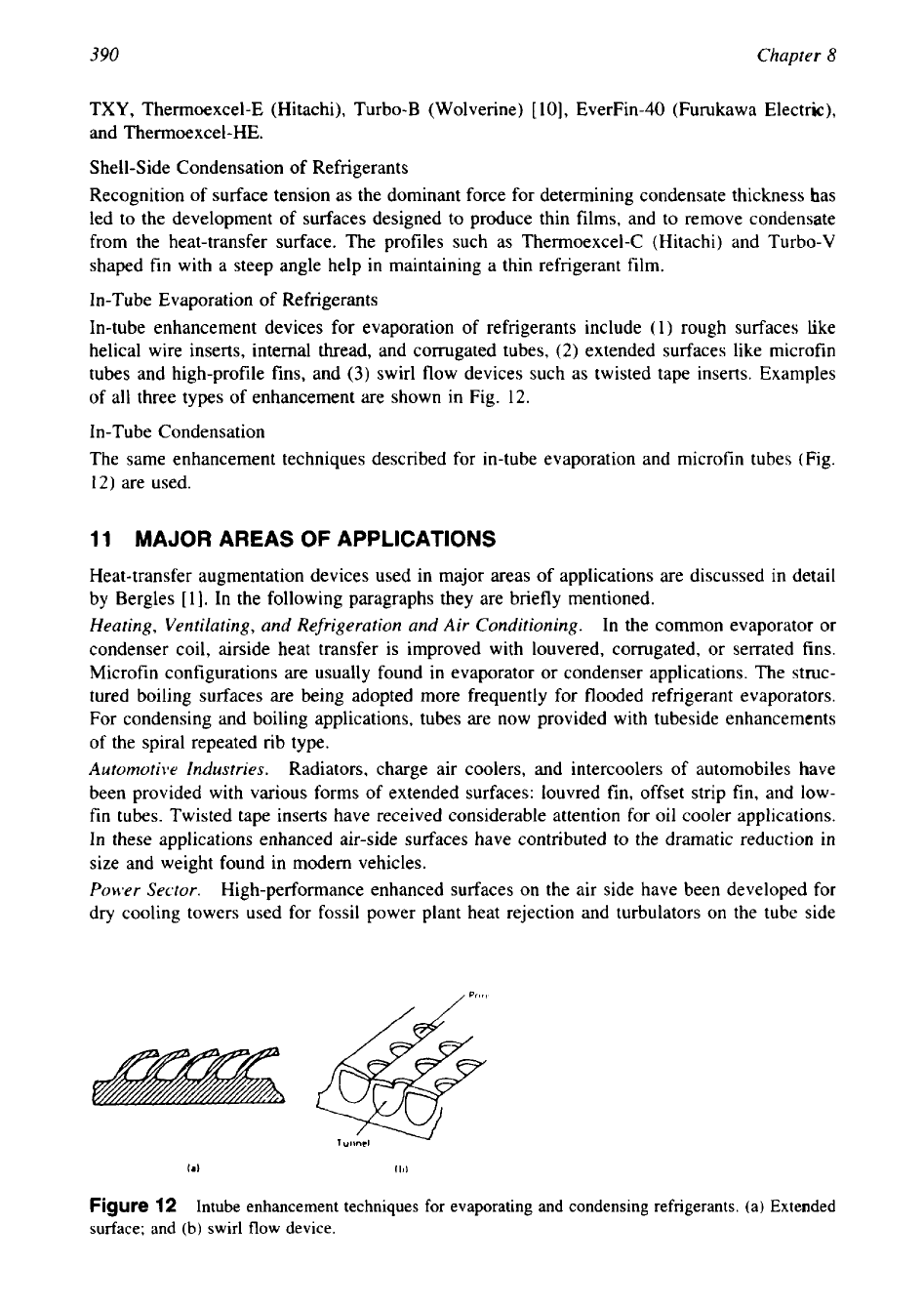
390
Chapter
8
TXY, Thermoexcel-E (Hitachi), Turbo-B (Wolverine)
[
101, EverFin-40 (Furukawa Electric),
and Thermoexcel-HE.
Shell-Side Condensation of Refrigerants
Recognition of surface tension as the dominant force for determining condensate thickness has
led to the development of surfaces designed to produce thin films, and to remove condensate
from the heat-transfer surface. The profiles such as Thermoexcel-C (Hitachi) and Turbo-V
shaped fin with a steep angle help in maintaining a thin refrigerant film.
In-Tube Evaporation of Refrigerants
In-tube enhancement devices for evaporation of refrigerants include
(
1) rough surfaces like
helical wire inserts, internal thread, and corrugated tubes,
(2)
extended surfaces like microfin
tubes and high-profile fins, and
(3)
swirl flow devices such as twisted tape inserts. Examples
of all three types of enhancement are shown in Fig. 12.
In-Tube Condensation
The same enhancement techniques described for in-tube evaporation and microfin tubes (Fig.
12)
are used.
11
MAJOR AREAS
OF
APPLICATIONS
Heat-transfer augmentation devices used in major areas of applications are discussed in detail
by Bergles
[
13. In the following paragraphs they are briefly mentioned.
Heating, Ventilating, and Refrigeration and Air Conditioning.
In the common evaporator or
condenser coil, airside heat transfer is improved with louvered, corrugated, or serrated fins.
Microfin configurations are usually found in evaporator or condenser applications. The struc-
tured boiling surfaces are being adopted more frequently for flooded refrigerant evaporators.
For condensing and boiling applications, tubes are now provided with tubeside enhancements
of the spiral repeated rib type.
Automotive Industries.
Radiators, charge air coolers, and intercoolers of automobiles have
been provided with various forms of extended surfaces: louvred fin, offset strip
fin,
and low-
fin tubes. Twisted tape inserts have received considerable attention for oil cooler applications.
In these applications enhanced air-side surfaces have contributed to the dramatic reduction in
size and weight found in modern vehicles.
Power Sector.
High-performance enhanced surfaces on the air side have been developed for
dry cooling towers used for fossil power plant heat rejection and turbulators on the tube side
Figure
12
Intube enhancement techniques for evaporating and condensing refrigerants. (a) Extended
surface; and (b) swirl flow device.
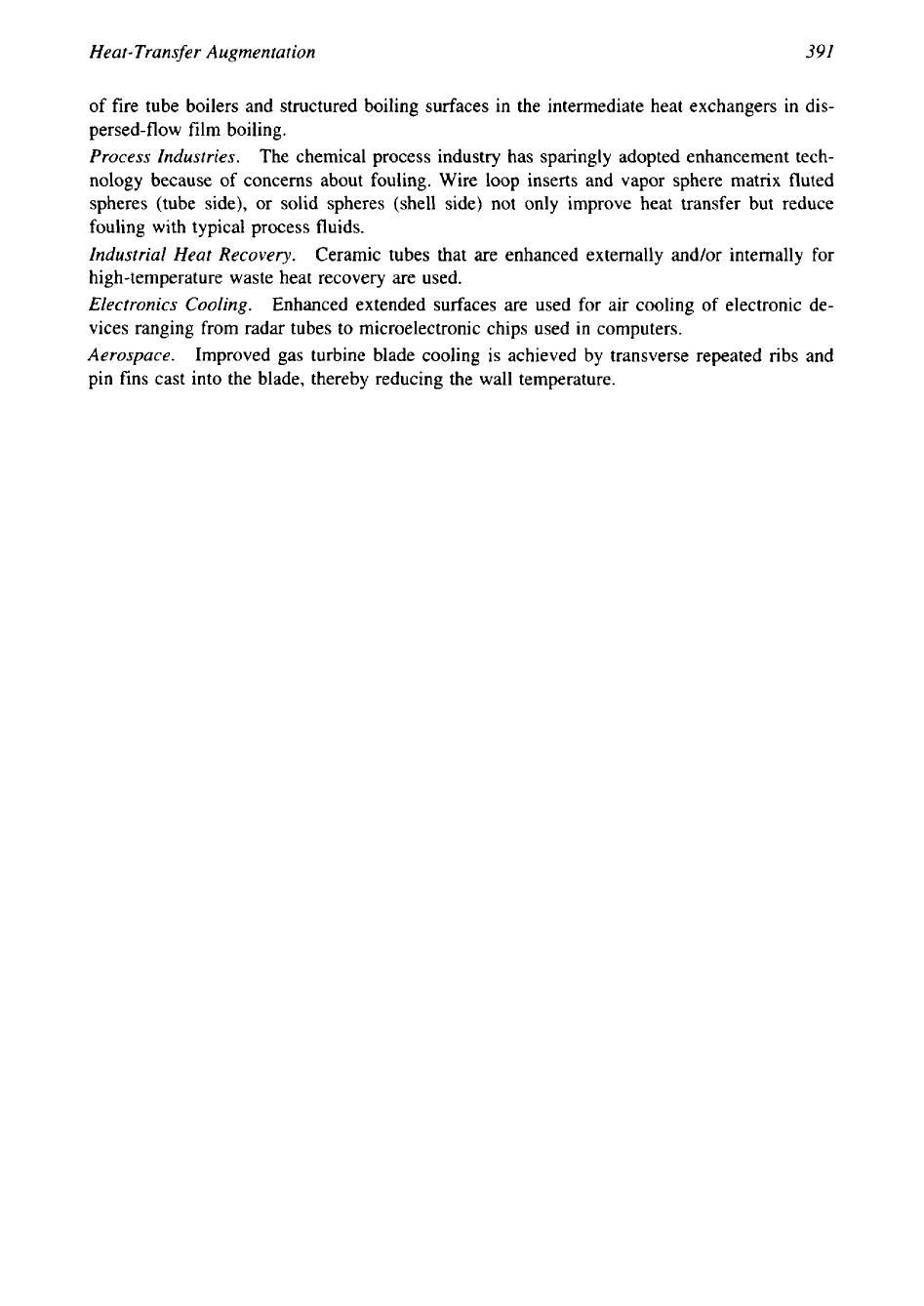
391
Heat- Transfer Augmentation
of fire tube boilers and structured boiling surfaces in the intermediate heat exchangers in dis-
persed-flow film boiling.
Process Industries.
The chemical process industry has sparingly adopted enhancement tech-
nology because
of
concerns about fouling. Wire loop inserts and vapor sphere matrix fluted
spheres (tube side), or solid spheres (shell side) not only improve heat transfer but reduce
fouling with typical process fluids.
Industrial Heat Recovery.
Ceramic tubes that are enhanced externally and/or internally for
high-temperature waste heat recovery are used.
Electronics Cooling.
Enhanced extended surfaces are used for air cooling of electronic de-
vices ranging from radar tubes to microelectronic chips used in computers.
Aerospace.
Improved gas turbine blade cooling is achieved by transverse repeated ribs and
pin fins cast into the blade, thereby reducing the wall temperature.
This page intentionally left blank
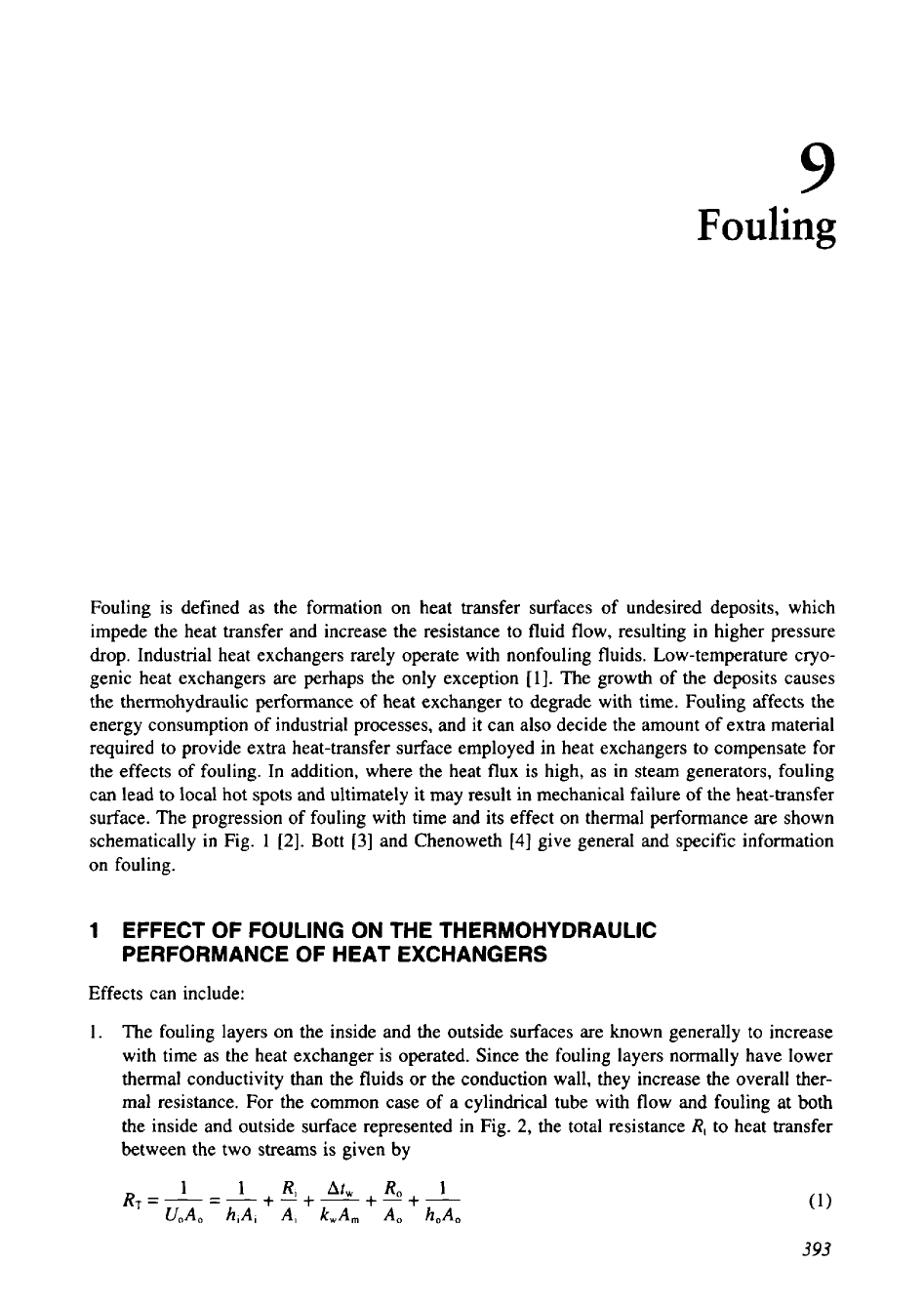
9
Fouling
Fouling is defined as the formation on heat transfer surfaces of undesired deposits, which
impede the heat transfer and increase the resistance to fluid flow, resulting in higher pressure
drop. Industrial heat exchangers rarely operate with nonfouling fluids. Low-temperature cryo-
genic heat exchangers are perhaps the only exception
[l].
The growth of the deposits causes
the thermohydraulic performance of heat exchanger to degrade with time. Fouling affects the
energy consumption of industrial processes, and it can also decide the amount of extra material
required to provide extra heat-transfer surface employed in heat exchangers to compensate for
the effects of fouling.
In
addition, where the heat flux
is
high, as in steam generators, fouling
can lead
to
local hot spots and ultimately it may result in mechanical failure of the heat-transfer
surface. The progression of fouling with time and its effect on thermal performance are shown
schematically in Fig.
1
[2].
Bott
[3]
and Chenoweth
[4]
give general and specific information
on fouling.
1
EFFECT OF FOULING ON THE THERMOHYDRAULIC
PERFORMANCE OF HEAT EXCHANGERS
Effects can include:
1. The fouling layers on the inside and the outside surfaces are known generally to increase
with time as the heat exchanger is operated. Since the fouling layers normally have lower
thermal conductivity than the fluids or the conduction wall, they increase the overall ther-
mal resistance. For the common case of a cylindrical tube with flow and fouling at
both
the inside and outside surface represented in Fig.
2,
the total resistance
R,
to heat transfer
between the two streams is given by
393
